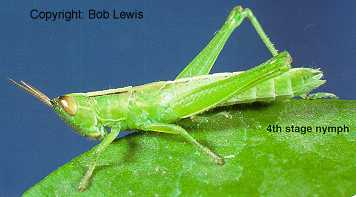Nymph description 8 of 15

Distribution

Nymph Description: Colour is mainly various shades of green but sometimes brown. Like the adults the texture is very smooth and almost shiny. Nymphs of this genus are very elongate and relatively small headed compared to most locust-like nymphs. Even when viewed from above, the body and head combined are thin. In early instars very strong, dark characteristic side body stripes starting near the top of the eyes define a strong lighter stripe along the top of the body. The dark stripes thin out pas the rear legs and get less distinct in later instars. Antennae short and only marginally longer than the height of the eye. No markings on the hind leg femur.
Confusion with Australian plague locust: Only in general size and colour where plague locust nymphs are green.
Confusion with spur-throated locust: Late instar Bermius nymphs may be confused with young Austracris nymphs (compare photos).
Confusion with Aiolopus: Similar sized, thin, often green body.Unique features: The light green colours on a smooth untextured and very elongate body, with no hind leg femur markings, no 'X' mark on the thorax, combined with the dark stripes in early instars. Aiolopus have a light stripe on top of the body but no dark side stripes.
Further information on this species: Description of adult
